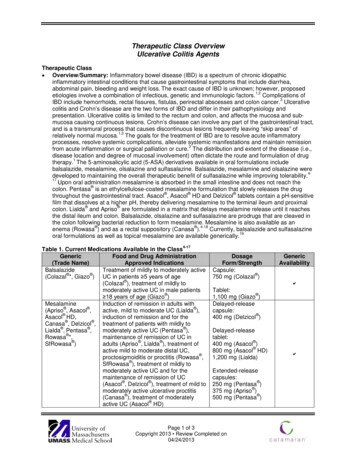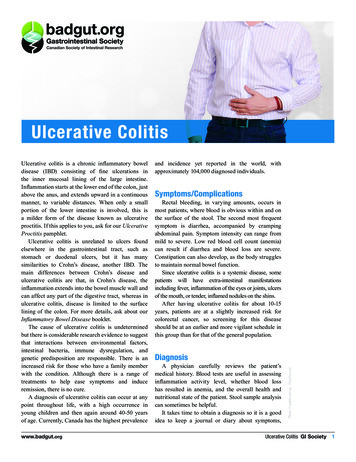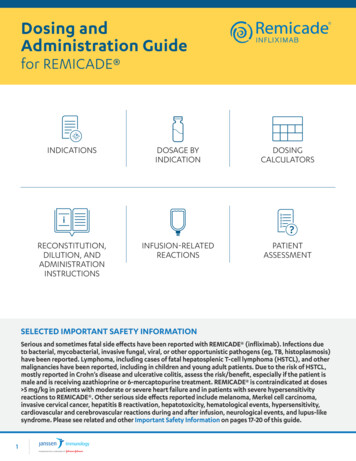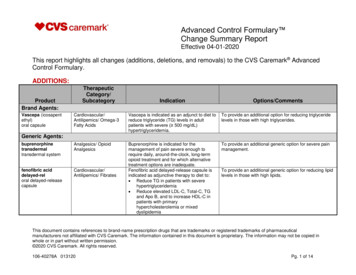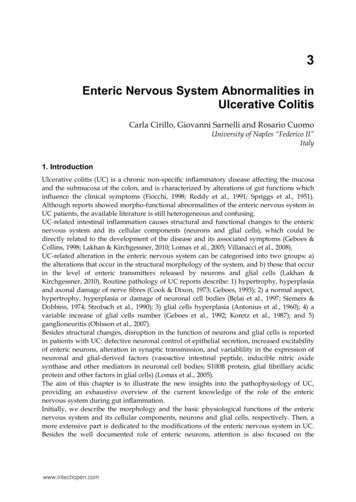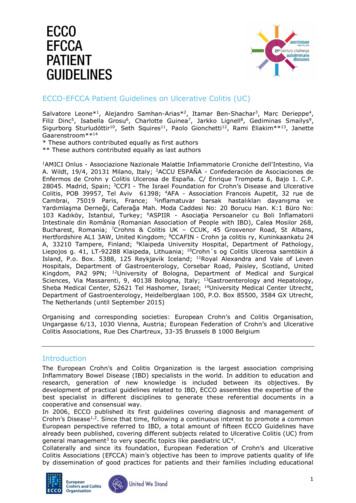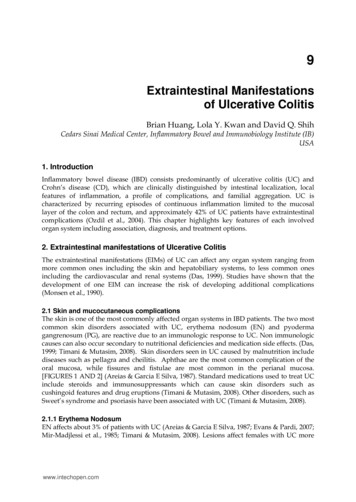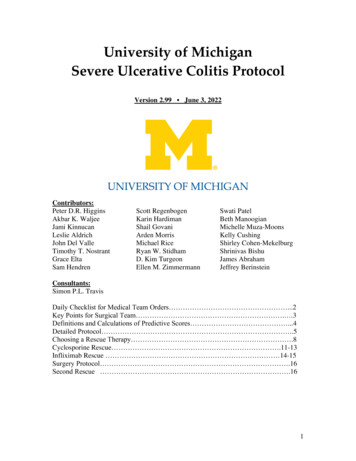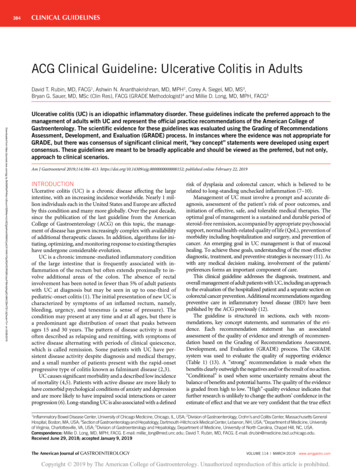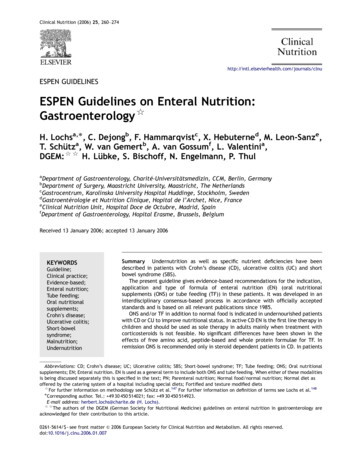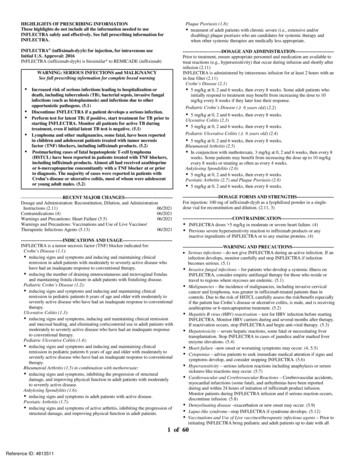
Transcription
Plaque Psoriasis (1.8):HIGHLIGHTS OF PRESCRIBING INFORMATIONThese highlights do not include all the information needed to useINFLECTRA safely and effectively. See full prescribing information forINFLECTRA. treatment of adult patients with chronic severe (i.e., extensive and/ordisabling) plaque psoriasis who are candidates for systemic therapy andwhen other systemic therapies are medically less appropriate.INFLECTRA (infliximab-dyyb) for injection, for intravenous useInitial U.S. Approval: 2016INFLECTRA (infliximab-dyyb) is biosimilar* to REMICADE (infliximab)WARNING: SERIOUS INFECTIONS and MALIGNANCYSee full prescribing information for complete boxed warning Increased risk of serious infections leading to hospitalization or death, including tuberculosis (TB), bacterial sepsis, invasive fungalinfections (such as histoplasmosis) and infections due to otheropportunistic pathogens. (5.1)Discontinue INFLECTRA if a patient develops a serious infection.Perform test for latent TB; if positive, start treatment for TB prior tostarting INFLECTRA. Monitor all patients for active TB duringtreatment, even if initial latent TB test is negative. (5.1)Lymphoma and other malignancies, some fatal, have been reportedin children and adolescent patients treated with tumor necrosisfactor (TNF) blockers, including infliximab products. (5.2)Postmarketing cases of fatal hepatosplenic T-cell lymphoma(HSTCL) have been reported in patients treated with TNF blockers,including infliximab products. Almost all had received azathioprineor 6-mercaptopurine concomitantly with a TNF blocker at or priorto diagnosis. The majority of cases were reported in patients withCrohn’s disease or ulcerative colitis, most of whom were adolescentor young adult males. (5.2)---------------------------RECENT MAJOR CHANGES------------------------------ Dosage and Administration: Reconstitution, Dilution, and AdministrationInstructions (2.11)06/2021Contraindications (4)06/2021Warnings and Precautions: Heart Failure (5.5)06/2021Warnings and Precautions: Vaccinations and Use of Live Vaccines/Therapeutic Infectious Agents S AND USAGE------------------------------- INFLECTRA is a tumor necrosis factor (TNF) blocker indicated for:Crohn’s Disease (1.1): reducing signs and symptoms and inducing and maintaining clinicalremission in adult patients with moderately to severely active disease whohave had an inadequate response to conventional therapy. reducing the number of draining enterocutaneous and rectovaginal fistulasand maintaining fistula closure in adult patients with fistulizing disease.Pediatric Crohn’s Disease (1.2): reducing signs and symptoms and inducing and maintaining clinicalremission in pediatric patients 6 years of age and older with moderately toseverely active disease who have had an inadequate response to conventionaltherapy.Ulcerative Colitis (1.3): reducing signs and symptoms, inducing and maintaining clinical remissionand mucosal healing, and eliminating corticosteroid use in adult patients withmoderately to severely active disease who have had an inadequate responseto conventional therapy.Pediatric Ulcerative Colitis (1.4): reducing signs and symptoms and inducing and maintaining clinicalremission in pediatric patients 6 years of age and older with moderately toseverely active disease who have had an inadequate response to conventionaltherapy.Rheumatoid Arthritis (1.5) in combination with methotrexate: reducing signs and symptoms, inhibiting the progression of structuraldamage, and improving physical function in adult patients with moderatelyto severely active disease.Ankylosing Spondylitis (1.6): reducing signs and symptoms in adult patients with active disease.Psoriatic Arthritis (1.7): reducing signs and symptoms of active arthritis, inhibiting the progression ofstructural damage, and improving physical function in adult patients.-------------------------DOSAGE AND ADMINISTRATION------------------------ Prior to treatment, ensure appropriate personnel and medication are available totreat reactions (e.g., hypersensitivity) that occur during infusion and shortly afterinfusion (2.11)INFLECTRA is administered by intravenous infusion for at least 2 hours with anin-line filter (2.11)Crohn’s Disease (2.1) 5 mg/kg at 0, 2 and 6 weeks, then every 8 weeks. Some adult patients whoinitially respond to treatment may benefit from increasing the dose to 10mg/kg every 8 weeks if they later lose their response.Pediatric Crohn’s Disease ( 6 years old) (2.2) 5 mg/kg at 0, 2 and 6 weeks, then every 8 weeks.Ulcerative Colitis (2.3) 5 mg/kg at 0, 2 and 6 weeks, then every 8 weeks.Pediatric Ulcerative Colitis ( 6 years old) (2.4) 5 mg/kg at 0, 2 and 6 weeks, then every 8 weeks.Rheumatoid Arthritis (2.5) In conjunction with methotrexate, 3 mg/kg at 0, 2 and 6 weeks, then every 8weeks. Some patients may benefit from increasing the dose up to 10 mg/kgevery 8 weeks or treating as often as every 4 weeks.Ankylosing Spondylitis (2.6) 5 mg/kg at 0, 2 and 6 weeks, then every 6 weeks.Psoriatic Arthritis (2.7) and Plaque Psoriasis (2.8) 5 mg/kg at 0, 2 and 6 weeks, then every 8 weeks.-----------------------DOSAGE FORMS AND STRENGTHS----------------------- For injection: 100 mg of infliximab-dyyb as a lyophilized powder in a singledose vial for reconstitution and dilution. (2.11, --------------------------------- INFLECTRA doses 5 mg/kg in moderate or severe heart failure. (4) Previous severe hypersensitivity reaction to infliximab products or anyinactive ingredients of INFLECTRA or to any murine proteins. (4)--------------------------WARNING AND PRECAUTIONS-------------------------- Serious infections – do not give INFLECTRA during an active infection. If aninfection develops, monitor carefully and stop INFLECTRA if infectionbecomes serious. (5.1) Invasive fungal infections – for patients who develop a systemic illness onINFLECTRA, consider empiric antifungal therapy for those who reside ortravel to regions where mycoses are endemic. (5.1) Malignancies – the incidence of malignancies, including invasive cervicalcancer and lymphoma, was greater in infliximab-treated patients than incontrols. Due to the risk of HSTCL carefully assess the risk/benefit especiallyif the patient has Crohn’s disease or ulcerative colitis, is male, and is receivingazathioprine or 6-mercaptopurine treatment. (5.2) Hepatitis B virus (HBV) reactivation – test for HBV infection before startingINFLECTRA. Monitor HBV carriers during and several months after therapy.If reactivation occurs, stop INFLECTRA and begin anti-viral therapy. (5.3) Hepatotoxicity – severe hepatic reactions, some fatal or necessitating livertransplantation. Stop INFLECTRA in cases of jaundice and/or marked liverenzyme elevations. (5.4) Heart failure –new onset or worsening symptoms may occur. (4, 5.5) Cytopenias – advise patients to seek immediate medical attention if signs andsymptoms develop, and consider stopping INFLECTRA. (5.6) Hypersensitivity – serious infusion reactions including anaphylaxis or serumsickness-like reactions may occur. (5.7) Cardiovascular and Cerebrovascular Reactions – Cerebrovascular accidents,myocardial infarctions (some fatal), and arrhythmias have been reportedduring and within 24 hours of initiation of infliximab product infusion.Monitor patients during INFLECTRA infusion and if serious reaction occurs,discontinue infusion. (5.8) Demyelinating disease –exacerbation or new onset may occur. (5.9) Lupus-like syndrome –stop INFLECTRA if syndrome develops. (5.12) Vaccinations and Use of Live vaccines/therapeutic infectious agents – Prior toinitiating INFLECTRA bring pediatric and adult patients up to date with all1 of 60Reference ID: 4813511
vaccinations. Live vaccines or therapeutic infectious agents should not begiven with INFLECTRA. At least a six month waiting period following birthis recommended before the administration of live vaccines to infants exposedin utero to infliximab products. (5.13)-------------------------------ADVERSE REACTIONS--------------------------------- Most common adverse reactions ( 10%) – infections (e.g. upper respiratory,sinusitis, and pharyngitis), infusion-related reactions, headache, and abdominalpain. (6.1)To report SUSPECTED ADVERSE REACTIONS, contactCELLTRION, Inc. at 1-800-383-7504 or FDA at 1-800-FDA-1088 ----DRUG INTERACTIONS--------------------------------- Other Biological Products– increased risk of serious infections (7.1)See 17 for PATIENT COUNSELING INFORMATION and MedicationGuide.*Biosimilar means that the biological product is approved based on datademonstrating that it is highly similar to an FDA-approved biological product,known as a reference product, and that there are no clinically meaningfuldifferences between the biosimilar product and the reference product.Biosimilarity of INFLECTRA has been demonstrated for the condition(s) of use(e.g., indication(s), dosing regimen(s)), strength(s), dosage form(s), and route(s)of administration described in its Full Prescribing Information.Revised: 6/2021FULL PRESCRIBING INFORMATION: CONTENTS*WARNING: SERIOUS INFECTIONS AND MALIGNANCY1INDICATIONS AND USAGE1.1 Crohn’s Disease1.2 Pediatric Crohn’s Disease1.3 Ulcerative Colitis1.4 Pediatric Ulcerative Colitis1.5 Rheumatoid Arthritis1.6 Ankylosing Spondylitis1.7 Psoriatic Arthritis1.8 Plaque Psoriasis2DOSAGE AND ADMINISTRATION2.1 Dosage in Adult Crohn’s Disease2.2 Dosage in Pediatric Crohn’s Disease2.3 Dosage in Adult Ulcerative Colitis2.4 Dosage in Pediatric Ulcerative Colitis2.5 Dosage in Rheumatoid Arthritis2.6 Dosage in Ankylosing Spondylitis2.7 Dosage in Psoriatic Arthritis2.8 Dosage in Plaque Psoriasis2.9 Assessment for Latent and Active Tuberculosis2.10 Administration Instructions Regarding Infusion Reactions2.11 Reconstitution, Dilution, and Administration Instructions3DOSAGE FORMS AND STRENGTHS4CONTRAINDICATIONS5WARNINGS AND PRECAUTIONS5.1 Serious Infections5.2 Malignancies5.3 Hepatitis B Virus Reactivation5.4 Hepatotoxicity5.5 Heart Failure5.6 Hematologic Reactions5.7 Hypersensitivity5.8 Cardiovascular and Cerebrovascular Reactions During and AfterInfusion5.9 Neurologic Reactions5.10 Concurrent Administration with Other Biological Products5.11 Switching Between Biological Disease-Modifying AntirheumaticDrugs (DMARDs)5.12 Autoimmunity5.13 Vaccinations and Use of Live Vaccines/Therapeutic InfectiousAgents6781011121314151617*Sections or subsections omitted from the full prescribing information are notlisted.2 of 60Reference ID: 4813511ADVERSE REACTIONS6.1 Clinical Trials Experience6.2 Immunogenicity6.3 Postmarketing ExperienceDRUG INTERACTIONS7.1 Other Biological Products7.2 Methotrexate and Other ConcomitantMedications7.3 Immunosuppressants7.4 Cytochrome P450 Substrates7.5 Live Vaccines/Therapeutic Infectious AgentsUSE IN SPECIFIC POPULATIONS8.1 Pregnancy8.2 Lactation8.4 Pediatric Use8.5 Geriatric UseOVERDOSAGEDESCRIPTIONCLINICAL PHARMACOLOGY12.1 Mechanism of Action12.2 Pharmacodynamics12.3 PharmacokineticsNONCLINICAL TOXICOLOGY13.1 Carcinogenesis, Mutagenesis, Impairment of FertilityCLINICAL STUDIES14.1 Adult Crohn’s Disease14.2 Pediatric Crohn’s Disease14.3 Adult Ulcerative Colitis14.4 Pediatric Ulcerative Colitis14.5 Rheumatoid Arthritis14.6 Ankylosing Spondylitis14.7 Psoriatic Arthritis14.8 Plaque PsoriasisREFERENCESHOW SUPPLIED/STORAGE AND HANDLINGPATIENT COUNSELING INFORMATION
FULL PRESCRIBING INFORMATIONWARNING: SERIOUS INFECTIONS and MALIGNANCYSERIOUS INFECTIONSPatients treated with infliximab products are at increased risk for developing seriousinfections that may lead to hospitalization or death [see Warnings and Precautions (5.1),Adverse Reactions (6.1)]. Most patients who developed these infections were takingconcomitant immunosuppressants such as methotrexate or corticosteroids.INFLECTRA should be discontinued if a patient develops a serious infection or sepsis.Reported infections include: Active tuberculosis, including reactivation of latent tuberculosis. Patients withtuberculosis have frequently presented with disseminated or extrapulmonary disease.Patients should be tested for latent tuberculosis before INFLECTRA use and duringtherapy. Treatment for latent infection should be initiated prior to INFLECTRA use. Invasive fungal infections, including histoplasmosis, coccidioidomycosis, candidiasis,aspergillosis, blastomycosis, and pneumocystosis. Patients with histoplasmosis or otherinvasive fungal infections may present with disseminated, rather than localized, disease.Antigen and antibody testing for histoplasmosis may be negative in some patients withactive infection. Empiric anti-fungal therapy should be considered in patients at risk forinvasive fungal infections who develop severe systemic illness. Bacterial, viral and other infections due to opportunistic pathogens, including Legionellaand Listeria.The risks and benefits of treatment with INFLECTRA should be carefully considered priorto initiating therapy in patients with chronic or recurrent infection.Patients should be closely monitored for the development of signs and symptoms ofinfection during and after treatment with INFLECTRA, including the possibledevelopment of tuberculosis in patients who tested negative for latent tuberculosis infectionprior to initiating therapy.MALIGNANCYLymphoma and other malignancies, some fatal, have been reported in children andadolescent patients treated with TNF blockers, including infliximab products [see Warningsand Precautions (5.2)].Postmarketing cases of hepatosplenic T-cell lymphoma (HSTCL), a rare type of T-celllymphoma, have been reported in patients treated with TNF blockers including infliximabproducts. These cases have had a very aggressive disease course and have been fatal.Almost all patients had received treatment with azathioprine or 6-mercaptopurineconcomitantly with a TNF blocker at or prior to diagnosis. The majority of reported caseshave occurred in patients with Crohn’s disease or ulcerative colitis and most were inadolescent and young adult males.3 of 60Reference ID: 4813511
1INDICATIONS AND USAGE1.1Crohn’s DiseaseINFLECTRA is indicated for: reducing signs and symptoms and inducing and maintaining clinical remission in adultpatients with moderately to severely active Crohn’s disease (CD) who have had aninadequate response to conventional therapy. reducing the number of draining enterocutaneous and rectovaginal fistulas and maintainingfistula closure in adult patients with fistulizing CD.1.2Pediatric Crohn’s DiseaseINFLECTRA is indicated for reducing signs and symptoms and inducing and maintaining clinicalremission in pediatric patients 6 years of age and older with moderately to severely active CD whohave had an inadequate response to conventional therapy.1.3Ulcerative ColitisINFLECTRA is indicated for reducing signs and symptoms, inducing and maintaining clinicalremission and mucosal healing, and eliminating corticosteroid use in adult patients withmoderately to severely active ulcerative colitis (UC) who have had an inadequate response toconventional therapy.1.4Pediatric Ulcerative ColitisINFLECTRA is indicated for reducing signs and symptoms and inducing and maintaining clinicalremission in pediatric patients 6 years of age and older with moderately to severely active UC whohave had an inadequate response to conventional therapy.1.5Rheumatoid ArthritisINFLECTRA, in combination with methotrexate, is indicated for reducing signs and symptoms,inhibiting the progression of structural damage, and improving physical function in adult patientswith moderately to severely active rheumatoid arthritis (RA).1.6Ankylosing SpondylitisINFLECTRA is indicated for reducing signs and symptoms in adult patients with active ankylosingspondylitis (AS).1.7Psoriatic ArthritisINFLECTRA is indicated for reducing signs and symptoms of active arthritis, inhibiting theprogression of structural damage, and improving physical function in adult patients with psoriaticarthritis (PsA).4 of 60Reference ID: 4813511
1.8Plaque PsoriasisINFLECTRA is indicated for the treatment of adult patients with chronic severe (i.e., extensiveand/or disabling) plaque psoriasis (Ps) who are candidates for systemic therapy and when othersystemic therapies are medically less appropriate. INFLECTRA should only be administered topatients who will be closely monitored and have regular follow-up visits with a physician [seeBoxed Warning, Warnings and Precautions (5)].2DOSAGE AND ADMINISTRATION2.1Dosage in Adult Crohn’s DiseaseThe recommended dosage of INFLECTRA is 5 mg/kg given as an intravenous induction regimenat 0, 2 and 6 weeks followed by a maintenance regimen of 5 mg/kg every 8 weeks thereafter forthe treatment of adults with moderately to severely active CD or fistulizing CD. For adult patientswho respond and then lose their response, consideration may be given to treatment with 10 mg/kgevery 8 weeks. Patients who do not respond by Week 14 are unlikely to respond with continueddosing and consideration should be given to discontinue INFLECTRA in these patients.2.2Dosage in Pediatric Crohn’s DiseaseThe recommended dosage of INFLECTRA for pediatric patients 6 years and older with moderatelyto severely active CD is 5 mg/kg given as an intravenous induction regimen at 0, 2 and 6 weeksfollowed by a maintenance regimen of 5 mg/kg every 8 weeks.2.3Dosage in Adult Ulcerative ColitisThe recommended dosage of INFLECTRA is 5 mg/kg given as an intravenous induction regimenat 0, 2 and 6 weeks followed by a maintenance regimen of 5 mg/kg every 8 weeks thereafter forthe treatment of adult patients with moderately to severely active UC.2.4Dosage in Pediatric Ulcerative ColitisThe recommended dosage of INFLECTRA for pediatric patients 6 years and older with moderatelyto severely active UC is 5 mg/kg given as an intravenous induction regimen at 0, 2 and 6 weeksfollowed by a maintenance regimen of 5 mg/kg every 8 weeks.2.5Dosage in Rheumatoid ArthritisThe recommended dosage of INFLECTRA is 3 mg/kg given as an intravenous induction regimenat 0, 2 and 6 weeks followed by a maintenance regimen of 3 mg/kg every 8 weeks thereafter forthe treatment of moderately to severely active RA. INFLECTRA should be given in combinationwith methotrexate. For patients who have an incomplete response, consideration may be given toadjusting the dosage up to 10 mg/kg every 8 weeks or treating as often as every 4 weeks bearingin mind that risk of serious infections is increased at higher doses per infusion or more frequentdosing [see Adverse Reactions (6.1)].5 of 60Reference ID: 4813511
2.6Dosage in Ankylosing SpondylitisThe recommended dosage of INFLECTRA is 5 mg/kg given as an intravenous induction regimenat 0, 2 and 6 weeks followed by a maintenance regimen of 5 mg/kg every 6 weeks thereafter forthe treatment of active AS.2.7Dosage in Psoriatic ArthritisThe recommended dosage of INFLECTRA is 5 mg/kg given as an intravenous induction regimenat 0, 2 and 6 weeks followed by a maintenance regimen of 5 mg/kg every 8 weeks thereafter forthe treatment of PsA. INFLECTRA can be used with or without methotrexate.2.8Dosage in Plaque PsoriasisThe recommended dosage of INFLECTRA in adult patients is 5 mg/kg given as an intravenousinduction regimen at 0, 2 and 6 weeks followed by a maintenance regimen of 5 mg/kg every 8weeks thereafter for the treatment of chronic severe (i.e., extensive and/or disabling) Ps.2.9Assessment for Latent and Active TuberculosisPrior to initiating INFLECTRA and periodically during therapy, patients should be evaluated foractive tuberculosis and tested for latent infection [see Warnings and Precautions (5.1)].2.10Administration Instructions Regarding Infusion ReactionsPrior to treatment, ensure appropriate personnel and medication are available to treat reactions(e.g., hypersensitivity, other reactions) that occur during infusion and shortly after infusion. Priorto infusion with INFLECTRA, patient may be premedicated with histamine-1 receptor antagonists,histamine-2 receptor antagonists, acetaminophen, and/or corticosteroids [see Warnings andPrecautions (5.7)].For mild to moderate reactions during the infusion, consider slowing or stopping the infusion.Upon resolution of these reactions, may reinitiate at a lower infusion rate and/or with histamine-1receptor antagonists, histamine-2 receptor antagonists, acetaminophen, and/or corticosteroids.Discontinue the infusion if the mild to moderate reactions reoccur.Discontinue the infusion if severe hypersensitivity reactions occur during the infusion.2.11Reconstitution, Dilution, and Administration InstructionsINFLECTRA is intended for use under the guidance and supervision of a healthcare provider. Thesupplied lyophilized powder must be reconstituted and diluted prior to administration. The infusionsolution should be prepared and administered by a trained medical professional using aseptictechnique by the following procedure:1.Calculate the dose, total volume of reconstituted INFLECTRA solution required and thenumber of INFLECTRA vials needed. More than one vial may be needed for a full dose.6 of 60Reference ID: 4813511
2.Reconstitute each 100 mg INFLECTRA vial with 10 mL of Sterile Water for Injection, USP,to obtain a concentration of 10 mg/ml, using a syringe equipped with a 21-gauge or smallerneedle as follows: Remove the flip-top from the vial and wipe the top with an alcohol swab.Insert the syringe needle into the vial through the center of the rubber stopper and direct thestream of Sterile Water for Injection, USP, to the glass wall of the vial. Gently swirl thesolution by rotating the vial to dissolve the lyophilized powder, which has a cake-likeappearance. Avoid prolonged or vigorous agitation. DO NOT SHAKE. Foaming of thesolution on reconstitution is not unusual.Allow the reconstituted solution to stand for 5 minutes. Visually inspect the reconstitutedsolution for particulate matter and discoloration. The reconstituted solution should becolorless to light yellow and opalescent, and the solution may develop a few translucentparticles as infliximab-dyyb is a protein. Do not use if the lyophilized powder has not fullydissolved or if opaque particles, discoloration, or other foreign particles are present. Do notstore unused reconstituted INFLECTRA solution. 3.Dilute the total volume of the reconstituted INFLECTRA solution to 250 mL* with sterile0.9% Sodium Chloride Injection, USP, (do not dilute with any other diluent) as follows: Withdraw a volume from the 0.9% Sodium Chloride Injection, USP, 250 mL bottle or bagequal to the total volume of reconstituted INFLECTRA required for a dose. Slowly add thetotal volume of reconstituted INFLECTRA solution from the vial(s) to the 250 mL infusionbottle or bag.Discard any unused portion of the reconstituted INFLECTRA solution remaining in thevial(s).Gently invert the bag to mix the solution. The resulting infusion concentration should rangebetween 0.4 mg/mL (minimum recommended concentration) and 4 mg/mL (maximumrecommended concentration) of infliximab-dyyb. *For volumes greater than 250 mL, either use a larger infusion bag (e.g. 500 mL) or multiple250 mL infusion bags to ensure that the concentration of the infusion solution does notexceed 4 mg/mL.4.The INFLECTRA infusion should begin within 3 hours of reconstitution and dilution. Theinfusion must be administered intravenously for at least 2 hours with an infusion set with anin-line, sterile, non-pyrogenic, low-protein-binding filter (pore size of 1.2 μm or less).5.Given that the vials do not contain antibacterial preservatives, discard any unused portion ofthe infusion solution (do not store for reuse).7 of 60Reference ID: 4813511
No physical biochemical compatibility studies have been conducted to evaluate the coadministration of INFLECTRA with other agents. INFLECTRA should not be infusedconcomitantly in the same intravenous line with other agents.3DOSAGE FORMS AND STRENGTHSFor injection: 100 mg of infliximab-dyyb as a white lyophilized powder in a single-dose vial forreconstitution and dilution.4CONTRAINDICATIONSThe use of INFLECTRA at doses 5 mg/kg is contraindicated in patients with moderate or severeheart failure [see Warnings and Precautions (5.5) and Adverse Reactions (6.1)].INFLECTRA is contraindicated in patients with a previous severe hypersensitivity reaction toinfliximab products or any of the inactive ingredients of INFLECTRA or any murine proteins[severe hypersensitivity reactions have included anaphylaxis, hypotension, and serum sickness][see Warnings and Precautions (5.7) and Adverse Reactions (6.1)].5WARNINGS AND PRECAUTIONS5.1Serious InfectionsPatients treated with infliximab products are at increased risk for developing serious infectionsinvolving various organ systems and sites that may lead to hospitalization or death.Opportunistic infections due to bacterial, mycobacterial, invasive fungal, viral, or parasiticorganisms including aspergillosis, blastomycosis, candidiasis, coccidioidomycosis, cryptococcosis,histoplasmosis, legionellosis, listeriosis, pneumocystosis, salmonellosis and tuberculosis havebeen reported with TNF blockers. Patients have frequently presented with disseminated rather thanlocalized disease.Treatment with INFLECTRA should not be initiated in patients with an active infection, includingclinically important localized infections. Patients greater than 65 years of age, patients withcomorbid conditions and/or patients taking concomitant immunosuppressants such ascorticosteroids or methotrexate may be at greater risk of infection. The risks and benefits oftreatment should be considered prior to initiating therapy in patients: with chronic or recurrent infection;who have been exposed to tuberculosis;with a history of an opportunistic infection;who have resided or traveled in areas of endemic tuberculosis or endemic mycoses, such ashistoplasmosis, coccidioidomycosis, or blastomycosis; orwith underlying conditions that may predispose them to infection.8 of 60Reference ID: 4813511
TuberculosisCases of reactivation of tuberculosis or new tuberculosis infections have been observed in patientsreceiving infliximab products, including patients who have previously received treatment for latentor active tuberculosis. Cases of active tuberculosis have also occurred in patients being treatedwith infliximab products during treatment for latent tuberculosis.Patients should be evaluated for tuberculosis risk factors and tested for latent infection prior toinitiating INFLECTRA and periodically during therapy. Treatment of latent tuberculosis infectionprior to therapy with TNF blockers has been shown to reduce the risk of tuberculosis reactivationduring therapy. Induration of 5 mm or greater with tuberculin skin testing should be considered apositive test result when assessing if treatment for latent tuberculosis is needed prior to initiatingINFLECTRA, even for patients previously vaccinated with Bacille Calmette-Guérin (BCG).Anti-tuberculosis therapy should also be considered prior to initiation of INFLECTRA in patientswith a past history of latent or active tuberculosis in whom an adequate course of treatment cannotbe confirmed, and for patients with a negative test for latent tuberculosis but having risk factorsfor tuberculosis infection. Consultation with a physician with expertise in the treatment oftuberculosis is recommended to aid in the decision whether initiating anti-tuberculosis therapy isappropriate for an individual patient.Tuberculosis should be strongly considered in patients who develop a new infection duringINFLECTRA treatment, especially in patients who have previously or recently traveled tocountries with a high prevalence of tuberculosis, or who have had close contact with a person withactive tuberculosis.MonitoringPatients should be closely monitored for the development of signs and symptoms of infectionduring and after treatment with INFLECTRA, including the development of tuberculosis inpatients who tested negative for latent tuberculosis infection prior to initiating therapy. Tests forlatent tuberculosis infection may also be falsely negative while on therapy with INFLECTRA.INFLECTRA should be discontinued if a patient develops a serious infection or sepsis. A patientwho develops a new infection during treatment with INFLECTRA should be closely monitored,undergo a prompt and complete diagnostic workup appropriate for an immunocompromisedpatient, and appropriate antimicrobial therapy should be initiated.Invasive Fungal InfectionsFor patients who reside or travel in regions where mycoses are endemic, invasive fungal infectionshould be suspected if they develop a serious systemic illness. Appropriate empiric antifungaltherapy should be considered while a diagnostic workup is being performed. Antigen and antibodytesting for histoplasmosis may be negative in some patients with active infection. When feasible,9 of 60Reference ID: 4813511
the decision to administer empiric antifungal therapy in these patients should be made inconsultation with a physician with expertise in the diagnosis and treatment of invasive fungalinfections and should take into account both the risk for severe fungal infection and the risks ofantifungal therapy.5.2MalignanciesMalignancies, some fatal, have been reported among children, adolescents and young adults whoreceived treatment with TNF blockers (initiation of therapy 18 years of age), including infliximabproducts. Approximately half of these cases were lymphomas, including Hodgkin’s and non Hodgkin’s lymphoma. The other cases represented a variety of malignancies, including raremalignancies that are usually associated with immunosuppression and malignancies that are notusually observed in children and adolescents. The malignancies occurred after a median of 30months (range 1 to
Ulcerative Colitis (1.3): reducing signs and symptoms, inducing and maintaining clinical remission and mucosal healing, and eliminating corticosteroid use in adult patients with moderately to severely active disease who have had an inadequate response to conventional therapy. Pediatric Ulcerative Colitis (1.4):
